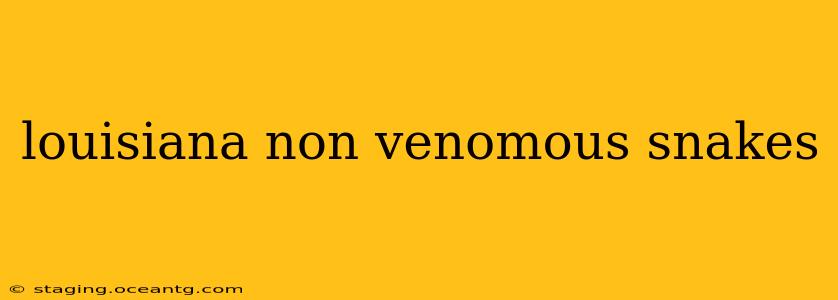Louisiana boasts a diverse reptile population, and a significant portion of that is made up of non-venomous snakes. These slithering creatures play vital roles in the state's ecosystem, controlling rodent populations and contributing to the delicate balance of nature. Understanding these snakes is crucial for appreciating their ecological importance and ensuring safe co-existence. This guide explores the common non-venomous snakes found in Louisiana, their identifying characteristics, and their habitats.
What are some common non-venomous snakes in Louisiana?
Louisiana is home to a surprising variety of non-venomous snakes. Some of the most common include:
-
Black Rat Snake ( Pantherophis spiloides): Often mistaken for venomous snakes due to their size and coloration, black rat snakes are powerful constrictors. They are typically black or dark brown and can reach impressive lengths. They are highly beneficial, as they prey on rodents.
-
Corn Snake ( Pantherophis guttatus): These snakes are popular in the pet trade due to their beautiful patterns and docile nature. In the wild, they exhibit varying colors and patterns, often reddish-brown with darker blotches. They feed primarily on rodents and are rarely aggressive towards humans.
-
Brown Snake ( Storeria dekayi): A small, slender snake with a uniform brown or grayish-brown coloration. They are often found in damp, wooded areas and feed on earthworms and slugs. They are harmless to humans.
-
Ribbon Snake ( Thamnophis sauritus): These snakes have distinctive long, slender bodies with three distinct stripes running the length of their backs. They are often found near water sources and feed on fish, frogs, and other aquatic creatures.
-
Rough Green Snake ( Opheodrys aestivus): A striking bright green snake that is easily identified by its keeled (ridged) scales, giving it a rough texture. They live in trees and shrubs, feeding on insects.
-
King Snake (various species): Louisiana is home to several species of king snakes, including the Eastern King Snake. These snakes are known for their striking patterns and their ability to consume venomous snakes. While they are not venomous themselves, their powerful jaws can inflict a painful bite if they feel threatened.
How can I identify non-venomous snakes in Louisiana?
Identifying snakes can be challenging, even for experienced herpetologists. However, some general characteristics can help distinguish non-venomous snakes from venomous ones in Louisiana:
-
Pupil Shape: Venomous snakes like copperheads and cottonmouths typically have elliptical or cat-like pupils, whereas non-venomous snakes usually have round pupils.
-
Head Shape: Venomous pit vipers (copperheads, cottonmouths, rattlesnakes) possess triangular-shaped heads, while most non-venomous snakes have more rounded or oval-shaped heads. This is not a foolproof method, however.
-
Heat-Sensing Pits: Pit vipers possess heat-sensing pits between their eyes and nostrils, allowing them to detect warm-blooded prey. Non-venomous snakes lack these pits.
-
Body Shape and Scales: Observe the snake's overall body shape and scale patterns. Many field guides and online resources provide detailed information on the scales and patterns of various Louisiana snake species.
Important Note: If you are unsure whether a snake is venomous, it is always best to err on the side of caution and maintain a safe distance. Never attempt to handle a snake unless you are a trained professional.
What should I do if I encounter a non-venomous snake?
Most non-venomous snakes pose no threat to humans. If you encounter one:
- Observe from a safe distance: Admire the snake from afar, taking note of its characteristics to help with identification.
- Give it space: Avoid approaching or attempting to handle the snake. Allow it to move away on its own.
- Educate yourself: Learn to identify common Louisiana snakes to better understand their behavior and habitat preferences.
- Protect your pets: Keep your pets on leashes or under your supervision, as some snakes may see small animals as potential prey.
Are there any dangerous non-venomous snakes in Louisiana?
While most non-venomous snakes are harmless, some larger species, like the black rat snake, can inflict a painful bite if they feel threatened. Their bite is not venomous, but the size of their teeth can cause significant discomfort.
How can I prevent snakes from entering my home?
Preventing snakes from entering your home involves simple steps:
- Seal cracks and holes: Inspect your home's exterior for any gaps or openings that snakes could use to enter.
- Remove debris and clutter: Keep your yard and surrounding areas clean and free of debris that could provide shelter for snakes.
- Maintain landscaping: Keep grass trimmed and shrubs pruned to reduce potential hiding places.
This comprehensive guide provides a solid foundation for understanding Louisiana's non-venomous snakes. Remember, responsible co-existence requires knowledge and respect for these fascinating creatures. Always prioritize safety and seek professional assistance if you are unsure about a snake's identity or behavior.
